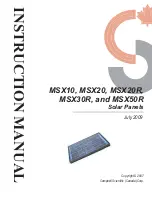
17
J. EXPANSION TANK: MINIMIZING WATER WASTAGE
In any hot water system, expansion of water will occur as it heats. When water expands, it has to be
controlled, as it cannot be compressed like air. See below for requirements pertaining to your application.
1. OPEN LOOP SYSTEMS
Open loop systems have a check valve/non-return valve on the cold main. This expanded water is
released via the pressure relief valve, which is mounted on the tank or solar collector loop. To prevent this
wasteful dumping of water, it is recommended to install an expansion vessel.
2. CLOSED LOOP SYSTEMS
Closed loop systems should always be installed with an expansion vessel. Refer to the solar expansion
vessel manufacturers’ guidelines regarding correct sizing.
3. DRAIN BACK SYSTEMS
Expansion tanks are not required in drain back system design.
K. LIGHTNING PROTECTION
To avoid lightning related damage or electrical safety issues, it is advisable to earth/ground the copper
circulation loop of the collector.
L. PIPE CONNECTIONS AND PIPE SIZE
HTP solar collectors are provided as standard with 1” NPT copper pipe inlet and outlet. For domestic
heating applications with 1 or 2 collectors, nominal ½” piping is suitable. For applications using 2 or more
solar collectors in series, it is advised to use nominal 3/4” piping. For connection of banks of collectors,
larger pipe sizes should be used as required for the given application, with consideration made to flow
rates, pressure drop and pump sizing.
The material used for the solar loop must be able to withstand the operating temperatures and pressures
to which the system may be exposed, due to normal or extraordinary conditions (e.g. pump failure or
power outage). Copper pipe is the most widely used piping material for solar applications. If it is decided
to use synthetic piping for the plumbing, HTP strongly recommends that copper pipe is used for at least
the most first 12feet of line connecting to both the inlet and outlet of the collector.
M. CONNECTION OF MULTIPLE COLLECTORS
When connecting collectors in series (maximum of 150 tubes), flexible connections should be used
between each collector in order to allow for expansion and contraction of the copper header with
temperature changes. Failure to use flexible connections between consecutive END port collectors may
result in damage to the header if the system stagnates.
NOTE:
The collector and collector plumbing should be sloped down toward the drain back reservoir at ¼”
per foot minimum to allow the system to drain.
NOTE: HTP DOES NOT WARRANT THE COLLECTOR AGAINST DAMAGE RESULTING FROM
POORLY MANAGED HEADER EXPANSION AND CONTRACTION.
N. POTABLE WATER
If the system is direct flow, meaning that potable water is flowing through the collector, any components
used in the system must meet potable water requirements.
Summary of Contents for HP-30SC
Page 37: ...37 MAINTENANCE NOTES ...
















































